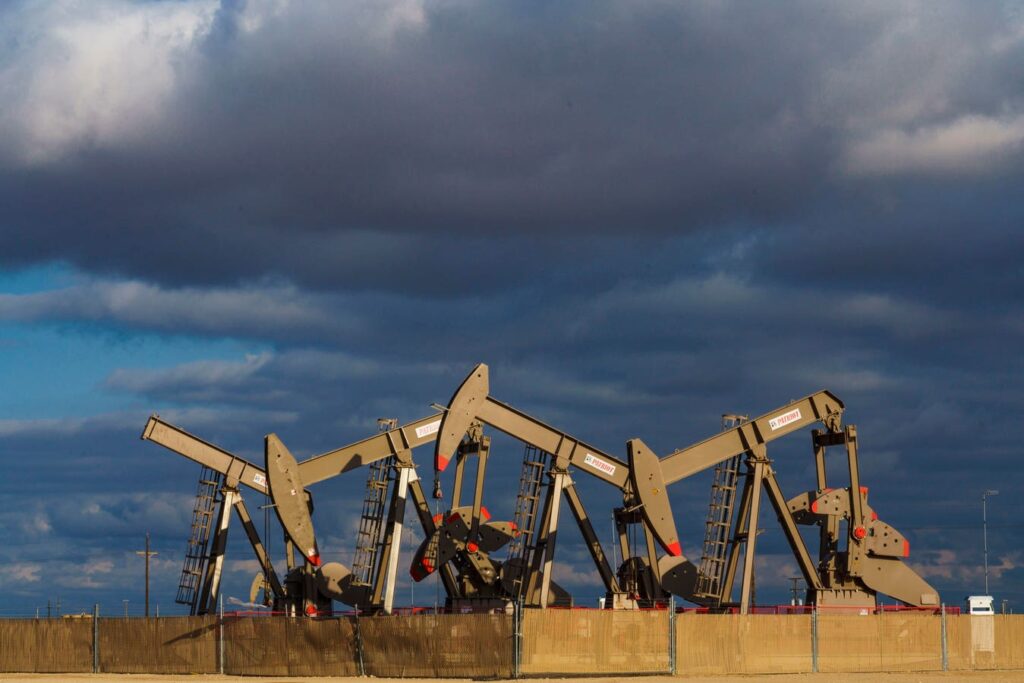Oil wells pumping outside of Midland Texas.
Global investment bank Goldman Sachs has reiterated its bearish stance on oil prices for this year and the next, on expectations of yet higher non-OPEC crude production, even when U.S. shale output is excluded.
In a note to its clients on Tuesday, the bank said it now expects global proxy oil benchmark Brent and U.S. benchmark West Texas Intermediate to average $56 and $52 per barrel respectively in 2026.
It also maintained its 2025 forecasts for Brent and WTI at $60 and $56 per barrel respectively. The reiteration of a bearish outlook by Goldman Sachs is a continuation of a series of recent downward oil price forecast revisions by major Wall Street banks and other forecasters.
For its part, Goldman Sachs based much of its analysis on oil production growth from non-OPEC “ex-Russia, ex-U.S. shale” producers likely accelerating to 1 million barrels per day over the next two years.
Non-OPEC producers Brazil, Canada, Guyana and Norway have all seen an uptick in crude oil production volumes capable of more than servicing global demand growth, which is currently said to be in the region of 1 million bpd.
Specifically on U.S. shale, Goldman Sachs analysts noted that the lower oil prices it predicts for the remainder of 2025 and 2026 – on the back of a near-term supply surplus – may lead to an earlier and lower peak in the production patch. Many, including oil industry insiders, believe this may be imminent and likely around 2027.
In March, at CERAWeek 2025, a major energy event organized by S&P Global, ConocoPhillips CEO Ryan Lance and Occidental Petroleum CEO Vicki Hollub joined many of their industry peers in predicting a U.S. crude production plateau sometime between 2027 and 2030.
The Energy Information Administration – statistical arm of the U.S. Department of Energy – has also predicted that a 2027 production plateau may occur.
In its Annual Energy Outlook 2025 published last month, the EIA said U.S. production will rise to 14 million barrels per day in 2027, and may likely stabilize at or near that level for a few years up until the early 2030s, before a gradual decline comes into view.
A climate of relatively low oil prices is already hitting industry confidence. But for now many U.S. explorers have hedging plans in place ranging from 6 to 18 months at $70-plus price levels. For that reason, the drop is unlikely to be an immediate one, but one that could well be pretty pronounced next year or in early in 2027.
However, over the near-term, higher U.S. production will likely add to the market surplus. Oil producers’ group OPEC+ is also unwinding its cuts and revisiting the prospect of higher production levels for next year.
In May, it agreed to up oil production for a second consecutive month, raising output for June by 411,000 bpd, having announced a similar hike for May. The combined hikes for April, May and June total 960,000 bpd. The figure represents around 44% of the 2.2 million bpd of previously agreed OPEC+ cuts since 2022.
It seems that a full blown glut might already be about to greet the market. Were that to be the case, the prediction of sub-$60 oil prices for 2026 by Goldman Sachs seems pretty plausible.
Disclaimer: The above commentary is meant to stimulate discussion based on the author’s opinion and analysis offered in a personal capacity. It is not solicitation, recommendation or investment advice to trade oil stocks, futures, options or products. Oil markets can be highly volatile and opinions in the sector may change instantaneously and without notice.
Read the full article here
